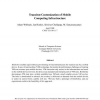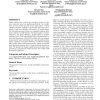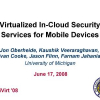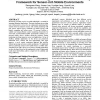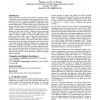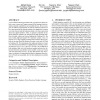MOBISYS
2008
ACM
14 years 4 months ago
2008
ACM
As computing capabilities of embedded devices increase, services such as Internet and multimedia are comportably supported by such devices. Users may demand for migrating services...
MOBISYS
2008
ACM
14 years 4 months ago
2008
ACM
There is an increasing tendency in sensor networks (and related networked embedded systems) to push more complexity and `intelligence' into end-nodes. This in turn leads to a ...
MOBISYS
2008
ACM
14 years 4 months ago
2008
ACM
Kimberley enables rapid software provisioning of fixed infrastructure for transient use by a mobile device. It uses virtual machine (VM) technology, but avoids the performance cha...
MOBISYS
2008
ACM
14 years 4 months ago
2008
ACM
Mobile phones have evolved into complex systems as they have more and more new applications built-in. As a result, they are less reliable and less secure than before. Virtual Mach...
MOBISYS
2008
ACM
14 years 4 months ago
2008
ACM
MOBISYS
2008
ACM
14 years 4 months ago
2008
ACM
Wireless sensor networks have been traditionally designed to be privately owned and used. Hence the two hallmark features of sensor networks, namely customized network application...
MOBISYS
2008
ACM
15 years 2 months ago
2008
ACM
Proactively providing services to mobile individuals is essential for emerging ubiquitous applications. The major challenge in providing users with proactive services lies in cont...
MOBISYS
2008
ACM
15 years 2 months ago
2008
ACM
Wireless interfaces are major power consumers on mobile systems. Considerable research has improved the energy efficiency of elongated idle periods or created more elongated idle ...
MOBISYS
2008
ACM
15 years 2 months ago
2008
ACM
Many people desire ubiquitous access to their personal computing environments. We present a system in which a user leverages a personal mobile device to establish trust in a publi...
MOBISYS
2008
ACM
15 years 2 months ago
2008
ACM
A novel behavioral detection framework is proposed to detect mobile worms, viruses and Trojans, instead of the signature-based solutions currently available for use in mobile devi...

